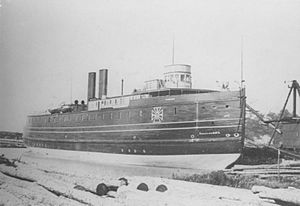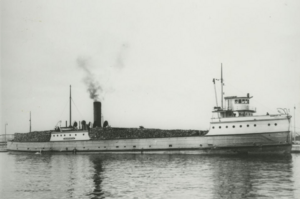SS Harriet B. facts for kids

The Harriet B. as the Shenango No.2
|
|
Quick facts for kids History |
|
|---|---|
| Name | Harriet B. |
| Operator | Hammermill Paper Company |
| Builder | Craig Shipbuilding |
| Yard number | 69 |
| Launched | October 25, 1895 |
| Out of service | May 3, 1922 |
| Identification | U.S. Registry #116695 |
| General characteristics | |
| Type | Barge |
| Tonnage |
|
| Length |
|
| Beam | 53 feet (16 m) |
| Depth | 19.33 feet (5.89 m) |
| Installed power | 2 x 1250-horsepower fore and aft compound steam engines |
|
|
|
| Location | Four miles off Two Harbors, Minnesota |
| Nearest city | Two Harbors, Minnesota |
| Built | 1895 |
| Architect | Craig Shipbuilding Company |
| Architectural style | shipwreck site |
| MPS | Minnesota's Lake Superior Shipwrecks MPS |
| NRHP reference No. | 100002773 |
| Added to NRHP | August 9, 2018 |
The Harriet B. was a large wooden ship that sailed on the Great Lakes in North America. It started as a railroad ferry named Shenango No.2. Later, it became a ship that carried large amounts of goods, called a bulk carrier. Finally, it was used as a barge, which is a flat-bottomed boat without its own power.
On May 3, 1922, the Harriet B. sank in Lake Superior. This happened after another ship, the Quincy A. Shaw, crashed into it. The wreck was found by accident in 2005. It was sitting upright and was still in good condition, about 656 feet (200 meters) deep. Because of its historical importance, the wreck of the Harriet B. was added to the National Register of Historic Places on August 9, 2018.
Contents
History of the Harriet B.
The ship was first named Shenango No.2. It was built in 1895 in Toledo, Ohio, by a company called Craig Shipbuilding. It was made for a company that helped transport goods across the Great Lakes.
The Shenango No.2 was one of the biggest wooden ships ever built. It was about 300 feet (91 meters) long. It was also 53 feet (16 meters) wide and 19.33 feet (5.89 meters) deep. The ship weighed about 1938 tons when empty. It had two powerful 1250-horsepower engines. The ship was launched on October 25, 1895.
In 1898, the Shenango No.2 was sold and renamed Muskegon. On October 20, 1898, the Muskegon hit a dock in Milwaukee, Wisconsin. Around 1900, the Muskegon hit ice and broke its steering part during a storm.
In 1901, the ship was sold again and renamed Pere Marquette 16. On December 21, 1901, it sank in Ludington, Michigan, but it was later pulled out of the water.
In 1918, the Pere Marquette 16 was sold to the Hammermill Paper Company. They changed the ship to carry pulpwood, which is wood used to make paper. At this time, it was renamed Harriet B.. In 1921, the Harriet B. was changed again to be used as a simple barge.
Final Journey and Sinking
On May 3, 1922, the freighter C.W. Jacob was pulling the Harriet B. and another barge named Crete. All three vessels were full of pulpwood. They arrived near Two Harbors, Minnesota, around 1:00 a.m. However, there was a lot of thick fog. The captain of the Jacob decided to wait for the fog to clear before going into the harbor.
The three vessels dropped anchor about one mile from shore. They were about three miles southwest of the harbor's light. Meanwhile, a steel ship called the Quincy A. Shaw was moving quickly across the lake. At 4:50 a.m., the front of the Shaw suddenly appeared out of the fog. It crashed into the left side of the Harriet B.. The crash almost cut the Harriet B. in half.
After the collision, the crew of the Harriet B. quickly moved onto the Shaw. The Harriet B. sank about twenty minutes later. After it sank, its wheelhouse (the part where the ship is steered) washed ashore nearby.
Discovery of the Wreck
The remains of the Harriet B. were found by accident in 2005. A research boat called Blue Heron, from the University of Minnesota Duluth, was exploring the bottom of the lake. They were doing a study of the lake's geology.
The crew of the Blue Heron contacted two people, Jerry Eliason and Randy Bebe. These two used special cameras that could be dropped into the water. They also used a tool called side-scan sonar, which uses sound waves to map the lake bottom. With these tools, they were able to confirm that the wreck was indeed the Harriet B..
The Harriet B. Today
Today, the Harriet B. wreck sits upright on the lakebed. It is almost completely whole. It rests about 656 feet (200 meters) deep, which is about four miles off Two Harbors, Minnesota.
Because the wreck is so deep, diving to it is not recommended. Jerry Eliason explained that even a short visit to the wreck would need at least eight hours of special stops on the way back up. These stops are needed to help divers safely adjust to the pressure changes. The Harriet B. is thought to be the most complete shipwreck found in Minnesota waters.




